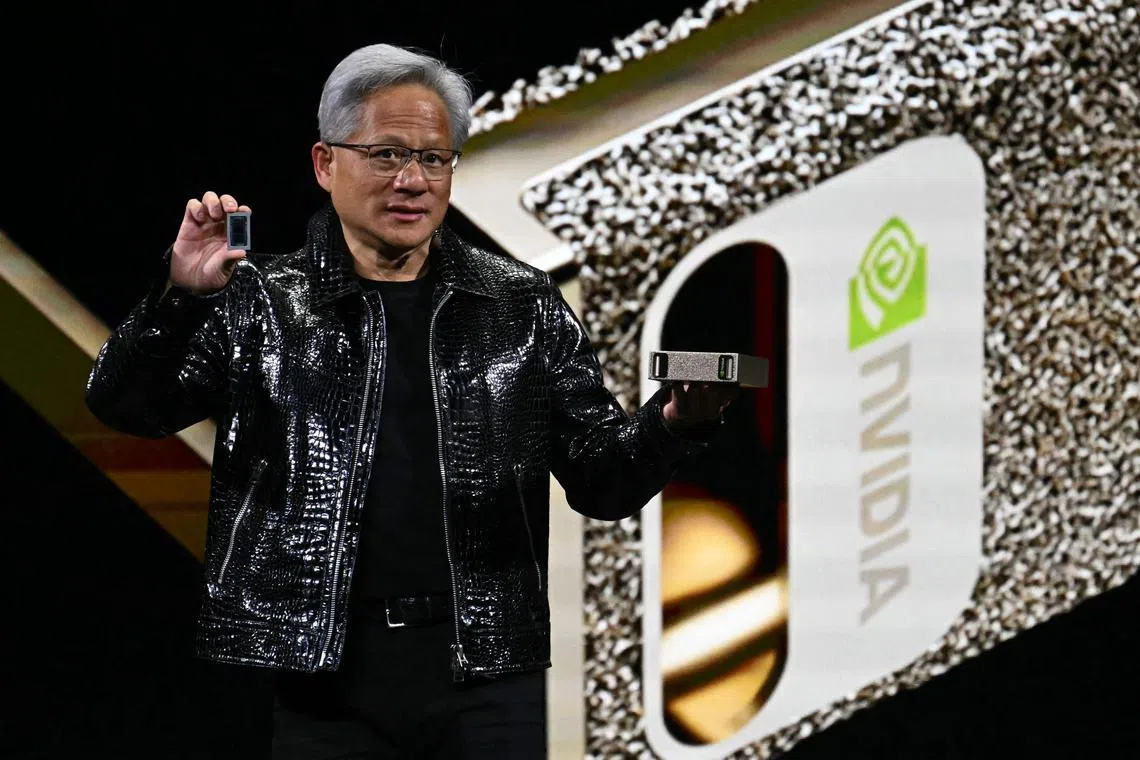Nvidia unveils gaming chips, desktop computer to protect AI lead
Sign up now: Get ST's newsletters delivered to your inbox

Nvidia CEO Jensen Huang speaking about the Project Digits desktop PC at the Consumer Electronics Show in Las Vegas on Jan 6.
PHOTO: AFP
Follow topic:
LAS VEGAS – Nvidia’s chief executive officer Jensen Huang has announced a raft of new chips, software and services, aiming to stay at the forefront of artificial intelligence (AI) computing.
Mr Huang took the stage at a packed arena in Las Vegas to kick off the Consumer Electronics Show on Jan 6 and present the new line-up, offering a vision for how AI will spread throughout the economy. The company wants its products to be the heart of a future tech world with a billion humanoid robots, 10 million automated factories, and 1.5 billion self-driving cars and trucks.
Interest in Nvidia’s products and Mr Huang’s forecasts has exploded as companies rush to deploy new AI computing gear. The CEO outlined Nvidia’s products and strategy to his audience of hundreds for more than 90 minutes, including tie-ups with Toyota Motor and MediaTek that sent their shares more than 3 per cent higher.
Even before Mr Huang’s presentation, shares in Asian chipmaking suppliers surged on optimism about the prospects of Nvidia, whose stock had just hit a fresh all-time high. Microsoft had in the prior week announced plans to spend US$80 billion (S$109 billion) on its AI data-centre build-out, much of which will be spent with Nvidia.
Before his main pitch about technology destined for data centres, Mr Huang offered up some advances for his traditional audience: gamers. Nvidia is launching an update to its GeForce GPUs – short for graphics processing units – which were created with the same Blackwell design that the company uses in its AI accelerators.
New GeForce 50 series cards will take advantage of Blackwell’s capabilities to create even more realistic experiences for computer gamers, the company said. While traditional graphics chips build an image by calculating the shade of each pixel in the picture, the new technology will lean more heavily on AI to anticipate what the next frame should look like.
The flagship RTX 5090 model will be available later in January for US$1,999, with less powerful cards following later. The RTX 5070, costing US$549, will debut in February with better performance than the prior range’s top model, the RTX 4090, Nvidia said.
As recently as 2022, gaming was Nvidia’s biggest source of sales. Now, the chipmaker’s data-centre operation is far larger. It is on course to contribute more than US$100 billion in 2025, as the company’s accelerator chips are prized by the world’s largest tech companies. The next step is rolling out hardware and software to a larger swathe of business and government agencies, helping to diversify Nvidia’s revenue.
Mr Huang announced that Toyota, the world’s biggest vehicle-maker, is now a customer for Nvidia’s autonomous driving AI products and will use its Drive chips and software.
Extending AI into more of the physical world will transform industries worth US$50 trillion, Nvidia said. But the move will also bring challenges. Robots and cars will require software that can handle real-life complexities in a safe way. The company has created Nvidia Cosmos to help make robots smarter and produce fully autonomous vehicles, Mr Huang said.
Cosmos technology is able to create video from inputs such as text. That video then becomes the basis of virtual training, helping reduce dependence on expensive and time-consuming real-world experimentation. The generated video can be searched and honed so that important but infrequent events – such as a car’s encounter with an emergency vehicle – can be tested repeatedly.
Nvidia is also working with Uber Technologies to develop self-driving technology. The millions of trips that Uber handles daily will provide a trove of data for training AI models.
Mass-market carmakers are going to shift towards using one computer and operating system for their entire model line-up, rather than segmenting systems by the class of vehicle, Nvidia said. That transition will set the table for a wider use of the chip designer’s comprehensive offerings, the company believes. To speed that up, Nvidia has had its products certified by government transportation safety organisations.
Nvidia is now also offering a desktop PC called Project Digits. The company is equipping the small US$3,000 device with a single Grace Blackwell Superchip – a combination of central processor and graphics semiconductor – working with a large chunk of memory and fast connectivity. The idea is to provide developers with hardware capable of running very large AI models, ones that current laptops will struggle to handle.
The new machines, developed in partnership with Taiwan’s MediaTek, will run a version of the Linux operating system and are not designed for everyday use. Instead, they are meant to help AI developers work locally when either connecting to the cloud or using conventional computers is not practical or possible. BLOOMBERG

